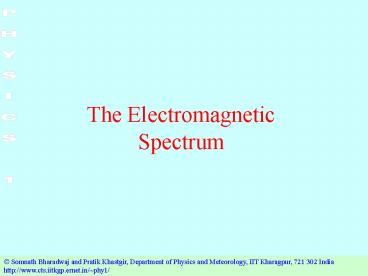The Electromagnetic Spectrum - PowerPoint PPT Presentation
1 / 17
Title:
The Electromagnetic Spectrum
Description:
http://www.cts.iitkgp.ernet.in/~phy1/ PHYSICS 1 ... http://www.cts.iitkgp.ernet.in/~phy1/ Infrared. 3 1011 Hz to 4 1014 Hz. Near IR 760 - 3000 nm ... – PowerPoint PPT presentation
Number of Views:95
Avg rating:3.0/5.0
Title: The Electromagnetic Spectrum
1
The Electromagnetic Spectrum
PHYSICS 1
- Somnath Bharadwaj and Pratik Khastgir,
Department of Physics and Meteorology, IIT
Kharagpur, 721 302 India - http//www.cts.iitkgp.ernet.in/phy1/
2
Radio wave
Less than 1 GHz
3
Microwave
1 GHz to 3 ? 1011 Hz
30 cm to 1 mm
4
Space communication
Atmosphere is transparent from less than 1 cm to
30 m
Also suitable for radio astronomy
5
The 21 cm HI radiation
6
Star and Gas Distribution
7
Radio Interferometric Arrays
32 MHz bands with 128 separate channels
8
HI in Galaxies
DDO 210 Source
Begum and Chengalur
Dwarf Irregular Galaxy
9
Cosmic Microwave Background Radiation
T2.73 K
CMBR
10
Blackbody Radiation
11
Molecular Rotations
Water 2.45 GHz used in microwave ovens Excites
Rotations of water molecules
50 GHz to 10 THz T-rays
12
Infrared
3 ? 1011 Hz to 4 ? 1014 Hz
Near IR 760 - 3000
nm Intermediate IR 3000 - 6000 nm Far IR
6000 - 15000 nm Extreme IR
15000nm 1 mm
Human body peaks at 10000 nm
13
Visible Light
3.84 ? 1014 Hz to 7.69 ? 1014 Hz
Mainly atomic transitions outer levels Hot
bodies 5000K
14
Ultraviolet
8 ? 1014 Hz to 3 ? 1016 Hz Enough energy to
ionize atoms in upper atmosphere Is harmful
absorbed by O3 in upper atmosphere Produced in
energetic atomic transitions
15
X-ray
2.4 ? 1016 Hz to 5 ? 1019 Hz Energetic electrons
incident on a metal Hot astrophysical sources
Black Holes Inner shell transitions in atoms
16
Centaurus Cluster
Credit J. Sanders, A. Fabian,
17
Gamma Rays
Frequency greater than 5 ? 1019 Hz Produced in
nuclear transitions Electron-positron
annihilation Easy to detect ionizes gas































